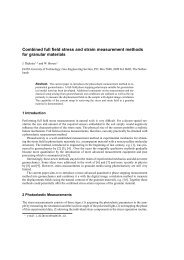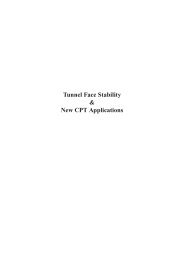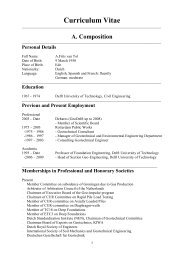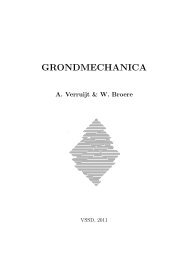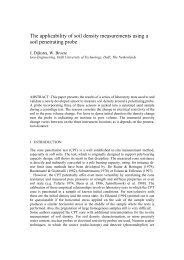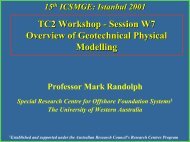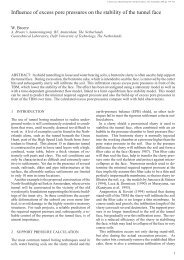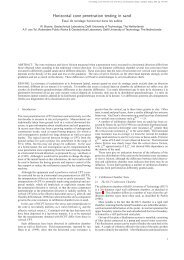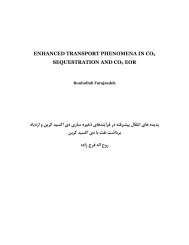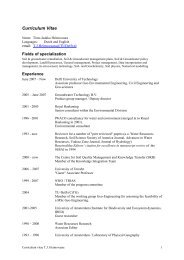Simultaneous measurement of hysteresis in ... - Geo-Engineering
Simultaneous measurement of hysteresis in ... - Geo-Engineering
Simultaneous measurement of hysteresis in ... - Geo-Engineering
Create successful ePaper yourself
Turn your PDF publications into a flip-book with our unique Google optimized e-Paper software.
GEOPHYSICS, VOL. 72, NO. 3 MAY-JUNE 2007; P. A41–A45, 4 FIGS., 1 TABLE.10.1190/1.2714684<strong>Simultaneous</strong> <strong>measurement</strong> <strong>of</strong> <strong>hysteresis</strong> <strong>in</strong> capillary pressure andelectric permittivity for multiphase flow through porous mediaWillem-Jan Plug 1 , Evert Slob 1 , Johannes Bru<strong>in</strong><strong>in</strong>g 1 , and Leticia M. Moreno Tirado 1ABSTRACTWe present a tool that simultaneously measures the complexpermittivity and the capillary pressure characteristics formultiphase flow. The sample holder is a parallel plate capacitor.A precision component analyzer is used to measure theimpedance amplitude and phase angle as a function <strong>of</strong> frequency1 kHz to 3 MHz. The complex impedance <strong>of</strong> thepartially saturated sample is directly related to the effectivecomplex permittivity. We have conducted ma<strong>in</strong> dra<strong>in</strong>age andma<strong>in</strong> imbibition cycles for unconsolidated sand-water-gasCO 2 /N 2 systems at 8-bar pressure and at temperatures between27°C and 28°C. Hysteresis <strong>in</strong> capillary pressure andelectric permittivity, as a result <strong>of</strong> phase distribution, is foundbetween dra<strong>in</strong>age and imbibition for f = 3 MHz and becomesmore pronounced at higher water saturations. Goodagreement <strong>of</strong> the measured electric permittivity with thecomplex refractive <strong>in</strong>dex model <strong>in</strong>dicates that <strong>in</strong>duced polarizationis not observed for 3 MHz and the water saturation isreasonably predicted. The experiments have been performedto study the capillary pressure behavior dur<strong>in</strong>g CO 2sequestration.INTRODUCTIONCapillary pressure P c versus water saturation S w relationshipsare used <strong>in</strong> subsurface flow eng<strong>in</strong>eer<strong>in</strong>g applications such as hydrocarbonproduction Delshad et al., 2003, soil remediation Dane etal., 1998, and carbon dioxide CO 2 sequestration Plug et al.,2006. Hysteresis between the dra<strong>in</strong>age decreas<strong>in</strong>g S w and imbibition<strong>in</strong>creas<strong>in</strong>g S w <strong>of</strong> capillary pressure is widely observed and extensively<strong>in</strong>vestigated Morrow, 1970; Hassanizadeh and Gray,1993; Reeves and Celia, 1996. This saturation history dependence<strong>of</strong> P c is related to contact angle <strong>hysteresis</strong> Anderson, 1986, irreversiblepore-scale fluid redistributions Morrow, 1970, and the <strong>in</strong>terfacialarea Reeves and Celia, 1996; Cheng et al., 2004. BecauseP c is an <strong>in</strong>terfacial property and strongly relates to the pressure andsaturation-<strong>in</strong>duced movement and distribution <strong>of</strong> the phases, the <strong>in</strong>terfacialarea per unit volume can be used as an <strong>in</strong>dicator <strong>of</strong> the thermodynamicenergy state Cheng et al., 2004. This results <strong>in</strong> auniquely def<strong>in</strong>ed relationship for P c as a function <strong>of</strong> S w and <strong>in</strong>terfacialarea. Furthermore, the <strong>in</strong>itial state <strong>of</strong> a flow process is <strong>in</strong>volvedvan Kats and van Duijn, 2001. Because all these phenomena alsocontribute to the complex permittivity <strong>of</strong> porous fluid-bear<strong>in</strong>g rocks,simultaneous <strong>measurement</strong>s <strong>of</strong> capillary pressure and permittivitymay reveal the fundamental physical behavior <strong>of</strong> capillary pressure<strong>hysteresis</strong>.It is known that the complex permittivity may be a function <strong>of</strong> frequencyf. Chelidze and Gueguen 1999 dist<strong>in</strong>guish two polarizationmechanisms. At frequencies below 10 MHz, relaxation processesare exhibited as a result <strong>of</strong> cluster<strong>in</strong>g <strong>of</strong> components and <strong>in</strong>ducedpolarization occurr<strong>in</strong>g at the solid/fluid <strong>in</strong>terface Chelidzeand Gueguen 1999 and at the <strong>in</strong>terface between the wett<strong>in</strong>g andnonwett<strong>in</strong>g phase Knight, 1991.The effects <strong>of</strong> the pore-scale fluid distribution on the electrical behaviordur<strong>in</strong>g imbibition and dra<strong>in</strong>age results <strong>in</strong> <strong>hysteresis</strong> Chelidzeet al., 1999. Pronounced <strong>hysteresis</strong> <strong>in</strong> resistivity is observed byFleury and Longeron 1998, Knight 1991, Elashahab et al. 1995,and Moss et al. 1999 and can be expla<strong>in</strong>ed by the percolation theoryChelidze et al., 1999. Nguyen et al. 1999a reported on <strong>hysteresis</strong><strong>of</strong> the real part <strong>of</strong> the permittivity. The change <strong>in</strong> electrical responseas a function <strong>of</strong> the rock’s wettability has been <strong>in</strong>vestigatedand described by Knight and Abad 1995, Elashahab et al. 1995,Moss et al. 1999, and Nguyen et al. 1999b.We conclude that different mechanisms are responsible for boththe capillary pressure and the complex permittivity behavior. Differentstudies on comb<strong>in</strong>ed capillary pressure and electrical resistivity<strong>measurement</strong>s are reported Elashahab et al., 1995; Fleury andLongeron, 1998; Moss et al., 1999. The real part <strong>of</strong> the permittivityand capillary pressures were measured simultaneously at frequenciesabove 100 MHz by Nguyen et al. 1999a.Manuscript received by the Editor November 10, 2006; revised manuscript received January 9, 2007; published onl<strong>in</strong>eApril 11, 2007.1 Delft University <strong>of</strong> Technology, Faculty <strong>of</strong> Civil Eng<strong>in</strong>eer<strong>in</strong>g and <strong>Geo</strong>sciences, Department <strong>of</strong> <strong>Geo</strong>technology, Delft, the Netherlands. E-mail:w.j.plug@tudelft.nl; e.c.slob@tudelft.nl; j.bru<strong>in</strong><strong>in</strong>g@tudelft.nl; leticia.morenotirado@shell.com.© 2007 Society <strong>of</strong> Exploration <strong>Geo</strong>physicists.All rights reserved.A41Downloaded 13 Sep 2010 to 145.94.64.59. Redistribution subject to SEG license or copyright; see Terms <strong>of</strong> Use at http://segdl.org/
A42Plug et al.In this study, we <strong>in</strong>vestigate the capillary pressure and electric behaviorfor the unconsolidated sand–distilled-water–gas system dur<strong>in</strong>gma<strong>in</strong> dra<strong>in</strong>age and ma<strong>in</strong> imbibition. The experiments are conductedat 8-bar pressure and a temperature between 27°C and 28°C.We have performed these experiments <strong>in</strong> the framework <strong>of</strong> the <strong>in</strong>vestigation<strong>of</strong> capillary pressure behavior dur<strong>in</strong>g CO 2 sequestrationapplications. The capillary pressure is measured under quasi-staticconditions us<strong>in</strong>g the setup discussed by Plug et al. 2006. The sampleholder is designed as a parallel-plate capacitor Knight and Nur,1987; Shen et al., 1987, where two sta<strong>in</strong>less steel end pieces act aselectrodes, and different frequencies can be applied 1 kHz to3 MHz. The advantage <strong>of</strong> this technique over coaxial transmission-l<strong>in</strong>emethods is that the sample rema<strong>in</strong>s <strong>in</strong>tact dur<strong>in</strong>g the <strong>measurement</strong>s,which is also the case for the coaxial waveguide methodTaherian et al., 1991. Calibration <strong>of</strong> the impedance tool is done us<strong>in</strong>gsubstances with known complex permittivity values Shen et al.,1987; Nguyen et al., 1999c and shows a maximum error <strong>of</strong> 4.5% <strong>in</strong>the real part. Furthermore, the experimental technique is validatedwith reproducible data, and a precision <strong>of</strong> 93.5% is found. Hysteresis<strong>in</strong> capillary pressure and electric permittivity is observed betweendra<strong>in</strong>age and imbibition at f = 3 MHz and becomes more pronouncedat higher water saturations. Comparison <strong>of</strong> the data with thecomplex refractive <strong>in</strong>dex model shows the reasonable prediction forthe water saturation. F<strong>in</strong>ally, we suggest that a better description <strong>of</strong>the capillary pressure <strong>hysteresis</strong> can be obta<strong>in</strong>ed from accurate permittivitydata than from water saturation alone.EXPERIMENTAL METHOD AND MATERIALSThe experimental setup is based on the porous plate techniquePlug et al., 2006. We apply quasi-static conditions Wildenschild etal., 2001, i.e., small <strong>in</strong>jection rates, so that viscous forces can be neglected.Aschematicoverview <strong>of</strong> the experimental setup is shown <strong>in</strong>Figure 1. Two syr<strong>in</strong>ge pumps are used and can be set to a constant <strong>in</strong>jectionrate or a constant pressure. The gas and the water phases are<strong>in</strong>jected or produced at the top and the bottom <strong>of</strong> the sample holder,respectively. The pressure difference between the gas and the waterphase is measured by a pressure-difference transducer PDT, accuracy±0.05 mbar, which is located at the same height as the middle <strong>of</strong>the sample. A temperature control system is used to ma<strong>in</strong>ta<strong>in</strong> a constanttemperature.The sample holder, see Figures 2 and 3, consists <strong>of</strong> three parts: apolyetheretherketone PEEK r<strong>in</strong>g, which conta<strong>in</strong>s the sand sample,and two sta<strong>in</strong>less steel end pieces. Two porous plates SIPERM R,Cr-Steel basis, with a permeability <strong>of</strong> 210 −12 m 2 and a porosity <strong>of</strong>0.32, support the sample and protect the hydrophilic membrane. Twosta<strong>in</strong>less steel plates, both with 32 perforations D p =5mm, areused at the top, directly above the sample, <strong>in</strong> comb<strong>in</strong>ation with a nylonfilter. Concentric flow grooves <strong>in</strong> the end pieces redistribute thephases over the sample area to avoid preferential flow. The differentparts <strong>of</strong> the sample holder are mounted together with four sta<strong>in</strong>lesssteel bolts at both the top and bottom.To obta<strong>in</strong> the permittivity <strong>of</strong> the sample <strong>in</strong>side the PEEK r<strong>in</strong>g, aprecision component analyzer Wayne-Kerr, 6640A is connected tothe sample holder Figure 1. The electrodes are the two end pieces<strong>of</strong> the sample holder, <strong>in</strong>clud<strong>in</strong>g the support plates. The PEEK materialis nonconductive and, hence, the sample holder acts as a parallelplatecapacitor. The impedance amplitude, Z, and the phase angle, rad, are measured as a function <strong>of</strong> the frequency and are directlyrelated to the effective complex permittivity s* <strong>of</strong> the sample,def<strong>in</strong>ed by s* = s − i s. Here, s and s represent the real andimag<strong>in</strong>ary part <strong>of</strong> the permittivity, respectively. In this study, we are<strong>in</strong>terested <strong>in</strong> s, and the results are presented as a function <strong>of</strong> S w .DATA ANALYSISWe def<strong>in</strong>e the capillary pressure as the difference <strong>in</strong> gas and waterbulk phase pressures. From the produced water volume we obta<strong>in</strong>the water saturation. The complex capacitance C * F is <strong>in</strong>verselyproportional to the complex impedance Z * by C * = iZ * −1 ,where is the angular frequency, def<strong>in</strong>ed by =2f, and Z *= Zexpi. The capacitor configuration results <strong>in</strong> a parallel circuit15 14781910316Gas supplyPerspex boxGPTvalve 4P gasT gas55ISCO CO 2TemperaturecontrolSampleholderP waterWPT∆ PPDTISCO water131112246Computerdata acquisitionComponent analyzerBall valveNeedle valveFigure 1. Schematic layout <strong>of</strong> the experimental setup. PDT: pressuredifference transducer; GPT: gas pressure transducer; WPT: waterpressure transducer.Figure 2. The sample holder: 1. Gas <strong>in</strong>let; 2. Water <strong>in</strong>let; 3. Sta<strong>in</strong>lesssteel end piece 1; 4. Sta<strong>in</strong>less steel end piece 2; 5. PEEK r<strong>in</strong>g; 6. Porousmedium diameter is 84 mm, height is 27 mm; 7. Perforatedplate diameter is 84 mm; 8. Perforated plate diameter is 90 mm;9. Concentric grooves; 10. Nylon filter pore size 210 m; 11. SIP-ERM plate diameter is 84 mm; 12. SIPERM plate diameter is90 mm; 13. Water-wet filter pore size 0.1 m; 14. O-r<strong>in</strong>gs2.1 mm; 15. O-r<strong>in</strong>gs 4 mm; 16. Sta<strong>in</strong>less steel bolts.Downloaded 13 Sep 2010 to 145.94.64.59. Redistribution subject to SEG license or copyright; see Terms <strong>of</strong> Use at http://segdl.org/
Capillary pressure and electric permittivityA43for which C * is considered as the sum <strong>of</strong> the capacitance <strong>of</strong> the sampleC s* , the PEEK r<strong>in</strong>g C PEEK , the cables C cables , the electrodes* ** *design C electrodes , and the background noise C noise . Under the assumptionthat only C s* is chang<strong>in</strong>g for different samples, C * can bewritten asC * = C * *s + C residual= 0 s * A sH+ C *residual. 1Here, 0 is the permittivity <strong>of</strong> free space, s* is the permittivity <strong>of</strong> the*sample, C residual F is the capacitance <strong>of</strong> the residual contributions,and H m and A s m 2 are, respectively, the height and the cross-sectionalarea <strong>of</strong> the sample. We use the complex refractive <strong>in</strong>dex CRImodel Roth et al., 1990; Seleznev et al., 2004 to evaluate the effectivepermittivity <strong>of</strong> the gra<strong>in</strong>-water-gas mixture, given by s = S w w + 1 −S w gas + 1 − gra<strong>in</strong> 2 ,12where is the porosity; and w, gas , and gra<strong>in</strong> are the water, gas, andporous medium permittivities, respectively. Furthermore, theHash<strong>in</strong>-Shtrikman bounds Hash<strong>in</strong> and Shtrikman, 1962 are used to<strong>in</strong>vestigate the validity <strong>of</strong> the results. The Hash<strong>in</strong>-Shtrikman boundsput limits on the effective electric permittivity <strong>of</strong> locally non<strong>in</strong>teract<strong>in</strong>gand macroscopically homogeneous, isotropic mixtures. Oursand samples satisfy these conditions.CALIBRATION AND SYSTEM ACCURACYTo obta<strong>in</strong> the most accurate data for the permittivity and the capillarypressure, different configurations <strong>of</strong> the sample holder are <strong>in</strong>vestigated.It appears that the type and comb<strong>in</strong>ation <strong>of</strong> the supportplates and the presence and number <strong>of</strong> the sta<strong>in</strong>less steel bolts do not<strong>in</strong>fluence the impedance <strong>measurement</strong>s.*The value for C residual equation 1 is obta<strong>in</strong>ed from air <strong>measurement</strong>sus<strong>in</strong>g s = 1. The capacitance C * , <strong>of</strong> the air-filled sampleholder is measured <strong>in</strong> the range <strong>of</strong> 20 to 21 ± 0.05 pF for the frequencyrange <strong>of</strong> 1 kHz to 3 MHz. A statistical analysis on 50 <strong>measurement</strong>sGorriti and Slob, 2005, for air and six different calibrationmaterials, see Table 1, is performed to determ<strong>in</strong>e the maximum<strong>measurement</strong> accuracy. It appears that the <strong>measurement</strong>s arevery stable. The mean and the relative error for both Z and <strong>of</strong> tengroups <strong>of</strong> two air <strong>measurement</strong>s are <strong>of</strong> the order <strong>of</strong> 0.1%.The impedance tool is calibrated for f = 3 MHz us<strong>in</strong>g materialswith known permittivity behavior with<strong>in</strong> the range <strong>of</strong> 2 to 25. In Table1, we present the theoretical permittivities s,theory , the measuredpermittivities and the absolute errors s obta<strong>in</strong>ed from an erroranalysis, and the accuracy <strong>of</strong> the 50 <strong>measurement</strong>s for each calibrationsample. High accuracy and good agreement is found for a widerange <strong>of</strong> permittivity values.3SAMPLE PREPARATION ANDEXPERIMENTAL PROCEDURE1612781065We <strong>in</strong>vestigate the capillary pressure and complex permittivitybehavior <strong>of</strong> the unconsolidated sand-water-gas CO 2 /N 2 system.For each experiment, a new sand pack is used. The average gra<strong>in</strong> sizefraction is 360 to 410 m, and the porosity is obta<strong>in</strong>ed with heliumat room temperature. For all samples, the porosity varies from 0.37to 0.38 ± 0.005.After the porosity <strong>measurement</strong>s, the total system is evacuated for1 hour. Subsequently, the sample holder is filled with distilled waterno sal<strong>in</strong>ity at a pressure <strong>of</strong> approximately 8 bar to dissolve small airbubbles. Valve 4 see Figure 1 is closed and the gas tub<strong>in</strong>g and pumpare filled with gas. The gas booster is used to br<strong>in</strong>g up the gas pressure.We set a constant temperature and let the system equilibrate fortwo days. When both the water and gas pressures are equal, a constantwater refill rate is applied, the gas pump is set to a constant pres-1311Table 1. Theoretical and measured permittivity values andtheir correspond<strong>in</strong>g error and accuracy for the calibrationsamples at f = 3 MHz and 25C. The theoretical values areobta<strong>in</strong>ed from Weast and Astle (1981).2Figure 3. Three-dimensional representation <strong>of</strong> the sample holdernot to scale. The numbers correspond to the legend <strong>of</strong> Figure 2. Forvisualization reasons, the rubber O-r<strong>in</strong>gs and the concentric groovesare not shown.416Sample s,theory s ± s Accuracy <strong>of</strong> sTeflon 2.00 1 MHz 2.06 ± 0.03 99.5%Perspex 2.76 1 MHz 2.84 ± 0.04 98.9%PVC 3.30 1 MHz 3.32 ± 0.04 99.3%1-Decanol 99% 8.10 static 8.49 ± 0.05 99.8%1-Butanol 17.80 static 18.32 ± 0.06 99.9%Ethanol 100% 24.30 static 24.64 ± 0.07 99.8%Downloaded 13 Sep 2010 to 145.94.64.59. Redistribution subject to SEG license or copyright; see Terms <strong>of</strong> Use at http://segdl.org/
A44Plug et al.Figure 4a shows the capillary pressure as a function <strong>of</strong> the watersaturation for the CO 2 -water-sand and the N 2 -water-sand systems.Both <strong>of</strong> the CO 2 experiments are performed at 8 bar and 28°C andshow good reproducibility. The relative error for the water saturationcalculation is ±12% for S w = 0.1 and decreases towards zero for S w= 1. For visualization reasons, the error bars for S w are not shown <strong>in</strong>Figure 4a. High precision <strong>in</strong> capillary pressure is obta<strong>in</strong>ed for the saturationrange between 0.15 and 0.72.As a result <strong>of</strong> a power failure atA Figure 4a, the primary dra<strong>in</strong>age data are miss<strong>in</strong>g near S w = 0.9for experiment 2. The nonmonotonic behavior <strong>of</strong> the imbibitioncurve, observed at po<strong>in</strong>t B experiment 1, is attributed to summertemperatures <strong>in</strong> the laboratory that exceeded the upper limit <strong>of</strong> thetemperature control system. Capillary pressure <strong>hysteresis</strong> is measuredand is similar for both experiments. The experiment with nitrogenN 2 is conducted at 8 bar, and a temperature <strong>of</strong> 27°C is applied.Both the dra<strong>in</strong>age and imbibition curves are slightly higher thanthose for CO 2 for S w 0.6, and a higher residual gas saturation S gr= 0.21 is obta<strong>in</strong>ed. The difference <strong>in</strong> residual gas saturation is expla<strong>in</strong>edby higher dissolution <strong>of</strong> CO 2 <strong>in</strong> water.In Figure 4b, s as function <strong>of</strong> S w , for the ma<strong>in</strong> dra<strong>in</strong>age processesis shown for f = 3 MHz. The <strong>measurement</strong> data can be fitted withthe CRI equation 2 model us<strong>in</strong>g w = 80, gra<strong>in</strong> = 6, and gas = 1 forwater, gra<strong>in</strong>s, and CO 2 /N 2 , respectively. This <strong>in</strong>dicates that S w is predictedreasonably from the <strong>measurement</strong>s. Because the sample porositiesare between 0.37 and 0.38, the porosity used <strong>in</strong> CRI is = 0.375. From Figure 4b it is clear that the measured effective permittivitiessatisfy the Hash<strong>in</strong>-Shtrikman bounds. This implies thatfor f = 3 MHz, the system can be considered to be a macroscopicallyhomogeneous and isotropic mixture.From the dra<strong>in</strong>age data <strong>of</strong> the two CO 2 experiments Figure 4b,we obta<strong>in</strong> the reproducibility <strong>of</strong> the permittivity <strong>measurement</strong>s. Aprecision <strong>of</strong> 93.5% is determ<strong>in</strong>ed for the water saturation range <strong>of</strong>0.15S w 0.72, which is lower than the precision for the P c curves.This is caused by difference <strong>in</strong> sand packs.Figure 4c plots s for the ma<strong>in</strong> dra<strong>in</strong>age and imbibition processesfor the first CO 2 experiment. The same <strong>in</strong>put parameters for the CRImodel used for the dra<strong>in</strong>age process result <strong>in</strong> good agreement for imbibition.It is clear that the Hash<strong>in</strong>-Shtrikman bounds are still satisfiedfor imbibition. Comparison between the curves <strong>in</strong> Figure 4cshows that s for imbibition is higher than for dra<strong>in</strong>age. Similar tothe capillary pressure <strong>hysteresis</strong>, the permittivity <strong>hysteresis</strong> <strong>in</strong>creasesfor <strong>in</strong>creas<strong>in</strong>g water saturation.Near S w = 0.85, the slope <strong>of</strong> s <strong>in</strong> each dra<strong>in</strong>age experiment showsan abrupt change Figure 4b. As a result <strong>of</strong> spontaneous redistribution<strong>of</strong> the phases and percolation mechanisms, the system undergoesa transition from trapped gas to trapped water Knight, 1991;Chelidze et al., 1999. The clear dip <strong>in</strong> dra<strong>in</strong>age, P c at S w = 0.85, forexperiment 3 supports this explanation. Similar permittivity behavioris also observed for the imbibition process near S w = 0.8 see Figure4c.Reasons for the permittivity <strong>hysteresis</strong> can be found <strong>in</strong> the distribution<strong>of</strong> the water and gas phase Chelidze et al., 1999 as well as <strong>in</strong>the change <strong>in</strong> <strong>in</strong>terfacial area dur<strong>in</strong>g dra<strong>in</strong>age and imbibition. Thefirst effect mentioned is observed <strong>in</strong> this study, the latter effect is exa)Capillary pressure (mbar)b)Real part permittivityc)Real part permittivity3025201510Dra<strong>in</strong>age(1) CO 2(2) CO 2(3) N 2AB5Imbibition00 0.2 0.4 0.6 0.8 1Water saturation (fraction)25(1) CO 2(2) CO 2(3) N 220H-S upper boundH-S lower bound151050 0.2 0.4 0.6 0.8 1Water saturation (fraction)(1) Ma<strong>in</strong> dra<strong>in</strong>age CO 220151050 0.2 0.4 0.6 0.8 1Water saturation (fraction)Figure 4. Ma<strong>in</strong> dra<strong>in</strong>age and imbibition capillary pressure curves afor CO 2 and N 2 for a flow rate <strong>of</strong> 0.5 ml/h. The curves for CO 2 co<strong>in</strong>cide,which clarifies the reproducibility <strong>of</strong> the method. The correspond<strong>in</strong>greal part <strong>of</strong> the permittivity s as a function <strong>of</strong> S w for thema<strong>in</strong> dra<strong>in</strong>age experiments are shown <strong>in</strong> b as well as the Hash<strong>in</strong>-Shtrikman upper and lower bounds. For experiment 1 CO 2 –distilled water–sand, the real part <strong>of</strong> the permittivity is shown <strong>in</strong> cfor both the ma<strong>in</strong> dra<strong>in</strong>age and imbibition process. The <strong>hysteresis</strong> <strong>in</strong>permittivity is clearly visible. All experiments are conducted forpressures <strong>of</strong> 8 bar and a temperature <strong>of</strong> 27°C and 28°C for, respectively,CO 2 and N 2 .sure, and valve 4 is opened. After the ma<strong>in</strong> dra<strong>in</strong>age process, thema<strong>in</strong> imbibition process starts when the water pump is set to a constant<strong>in</strong>jection rate.RESULTS AND DISCUSSIONDownloaded 13 Sep 2010 to 145.94.64.59. Redistribution subject to SEG license or copyright; see Terms <strong>of</strong> Use at http://segdl.org/
Capillary pressure and electric permittivityA45pected to be more pronounced for lower frequencies. Differentmechanisms, such as dipole polarization, polarization <strong>in</strong> the electricaldouble layer Chelidze et al., 1999, and conduction on the watergas<strong>in</strong>terface Knight, 1991 are, therefore, considered to be the keyto improve the current knowledge <strong>of</strong> capillary <strong>hysteresis</strong> as a function<strong>of</strong> the <strong>in</strong>terfacial area, especially when pronounced permittivity<strong>hysteresis</strong> is observed at high water contents.CONCLUSIONSThe <strong>measurement</strong>s presented <strong>in</strong> this work show that it is possibleto measure the capillary pressure and the permittivity properties simultaneouslywith a nondestructive technique. The tool is widelyapplicable and can be used for fluid-bear<strong>in</strong>g rocks and soils, and theresults are, therefore, relevant for applications <strong>in</strong> near-surface aswell as exploration and production geophysics. Moreover, the experimentallyobserved <strong>hysteresis</strong> <strong>in</strong> the real part <strong>of</strong> the complex electricpermittivity provides evidence that a better description <strong>of</strong> thecapillary pressure <strong>hysteresis</strong> can be obta<strong>in</strong>ed than that from watersaturation alone. Because the presence <strong>of</strong> water plays a dom<strong>in</strong>antrole <strong>in</strong> the permittivity behavior, low frequency <strong>measurement</strong>s arenecessary to assist <strong>in</strong> the <strong>in</strong>terpretation <strong>of</strong> the permittivity <strong>hysteresis</strong><strong>in</strong> terms <strong>of</strong> <strong>in</strong>terfacial activities.ACKNOWLEDGMENTSThe research presented <strong>in</strong> this work was carried out as part <strong>of</strong> theCATO program: CO 2 Capture, Transport and Storage <strong>in</strong> the Netherlandshttp://www.CO2-cato.nl/ and the DIOC water project. Thef<strong>in</strong>ancial support is gratefully acknowledged. We thank L. Vogt, P. S.A. de Vreede, H. G van Asten, and H. K. J. Heller for technical support.We thank the reviewers for their constructive remarks.REFERENCESAnderson, W. G., 1986, Wettability literature survey — Part 2: Wettability<strong>measurement</strong>: Journal <strong>of</strong> Petroleum Technology, 1246–1262.Chelidze, T. L., and Y. Gueguen, 1999, Electrical spectroscopy <strong>of</strong> porousrocks: A review — I. Theoretical model: <strong>Geo</strong>physical Journal International,137, 1–15.Chelidze, T. L., Y. Gueguen, and C. Ruffet, 1999, Electrical spectroscopy <strong>of</strong>porous rocks: A review — II. Experimental results and <strong>in</strong>terpretation:<strong>Geo</strong>physical Journal International, 137, 16–34.Cheng, J.-T., L. J. Pyrak-Nolte, D. D. Nolte, and N. J. Giordano, 2004, L<strong>in</strong>k<strong>in</strong>gpressure and saturation through <strong>in</strong>terfacial areas <strong>in</strong> porous media:<strong>Geo</strong>physical Research Letters, 31, L08502; http://dx.doi.org/10.1029/2003GL019282.Dane, J. H., C. H<strong>of</strong>stee, and A. T. Corey, 1998, <strong>Simultaneous</strong> <strong>measurement</strong><strong>of</strong> capillary pressure, saturation, and effective permeability <strong>of</strong> immiscibleliquids <strong>in</strong> porous media: Water Resources Research, 34, 3687–3692.Delshad, M., R. J. Lenhard, M. Oostrom, and G. A. Pope, 2003, Amixed-wethysteretic relative permeability and capillary pressure model for reservoirsimulations: SPE Reservoir Evaluation and Eng<strong>in</strong>eer<strong>in</strong>g, 6, 328–334.Elashahab, B. M., X. D. J<strong>in</strong>g, and J. S. Archer, 1995, Resistivity <strong>in</strong>dex andcapillary pressure <strong>hysteresis</strong> for rock samples <strong>of</strong> different wettability characteristics:Presented at the SPE Middle East Oil Show, Paper 29888.Fleury, M., and D. Longeron, 1998, Comb<strong>in</strong>ed resistivity and capillary pressure<strong>measurement</strong>s us<strong>in</strong>g micropore membrane technique: Journal <strong>of</strong> PetroleumScience and Eng<strong>in</strong>eer<strong>in</strong>g, 19, 73–79.Gorriti, A. G., and E. C. Slob, 2005, A new tool for accurate S-parameters<strong>measurement</strong>s and permittivity reconstruction: IEEE Transactions on<strong>Geo</strong>science and Remote Sens<strong>in</strong>g, 43, 1727–1735.Hash<strong>in</strong>, Z., and S. Shtrikman, 1962, A variational approach to the theory <strong>of</strong>the effective magnetic permeability <strong>of</strong> multiphase materials: Journal <strong>of</strong>Applied Physics, 33, 3125–3131.Hassanizadeh, S. M., and W. G. Gray, 1993, Thermodynamic basis <strong>of</strong> capillarypressure <strong>in</strong> porous media: Water Resources Research, 29, 3389–3405.Knight, R., 1991, Hysteresis <strong>in</strong> the electrical resistivity <strong>of</strong> partially saturatedsandstones: <strong>Geo</strong>physics, 56, 2139–2147.Knight, R., and A. Abad, 1995, Rock/water <strong>in</strong>teraction <strong>in</strong> dielectric properties:Experiments with hydrophobic sandstones: <strong>Geo</strong>physics, 60,431–436.Knight, R. J., and A. Nur, 1987, The dielectric constant <strong>of</strong> sandstones, 60 kHzto 4 MHz: <strong>Geo</strong>physics, 52, 644–654.Morrow, N., 1970, Physics and thermodynamics <strong>of</strong> capillary action <strong>in</strong> porousmedia: Industrial and Eng<strong>in</strong>eer<strong>in</strong>g Chemistry, 62, 32–56.Moss, A. K., X. D. J<strong>in</strong>g, and J. S. Archer, 1999, Laboratory <strong>in</strong>vestigation <strong>of</strong>wettability and <strong>hysteresis</strong> effects on resistivity <strong>in</strong>dex and capillary pressurecharacteristics: Journal <strong>of</strong> Petroleum Science and Eng<strong>in</strong>eer<strong>in</strong>g, 24,231–242.Nguyen, B.-L., J. Bru<strong>in</strong><strong>in</strong>g, and E. C. Slob, 1999a, Hysteresis <strong>in</strong> dielectricproperties <strong>of</strong> fluid-saturated porous media: Presented at the SPE Asia PacificImproved Oil Recovery Conference, Paper 57305.——–, 1999b, Effects <strong>of</strong> wettability on dielectric properties <strong>of</strong> porous media:Presented at the SPE Annual Technical Conference and Exhibition, Paper56507.Nguyen, B.-L., A. M. Geels, J. Bru<strong>in</strong><strong>in</strong>g, and E. C. Slob, 1999c, Calibration<strong>measurement</strong>s <strong>of</strong> dielectric properties <strong>of</strong> porous media: SPE Journal, 4,353–359.Plug, W. J., S. Mazumder, J. Bru<strong>in</strong><strong>in</strong>g, K. H. A. A. Wolf, and N. Siemons,2006, Capillary pressure and wettability behavior <strong>of</strong> the coal-water-carbondioxide system at high pressures: Presented at the International CBMSymposium, Paper 606.Reeves, P. C., and M. A. Celia, 1996, A functional relationship between capillarypressure, saturation and <strong>in</strong>terfacial area as revealed by a pore-scalenetwork model: Water Resources Research, 32, 2345–2358.Roth, K., R. Schul<strong>in</strong>, H. Flühler, and W. Att<strong>in</strong>ger, 1990, Calibration <strong>of</strong> timedoma<strong>in</strong> reflectometry for water content <strong>measurement</strong> us<strong>in</strong>g a compositedielectric approach: Water Resources Research, 26, 2267–2273.Seleznev, N., A. Boyd, T. Habashy, and S. Luthi, 2004, Dielectric mix<strong>in</strong>glaws for fully and partially saturated carbonate rocks: Proceed<strong>in</strong>gs <strong>of</strong> theSPWLA45thAnnual Symposium, Paper CCC.Shen, L. C., H. Marouni, Y. Zhang, and X. Shi, 1987, Analysis <strong>of</strong> the paralleldisksample holder for dielectric permittivity <strong>measurement</strong>: IEEE Transactionson <strong>Geo</strong>science and Remote Sens<strong>in</strong>g, 25, 534–539.Taherian, M. R., D. J. Yuen, T. L. Habashy, and J. A. Kong, 1991, A coaxialcircularwaveguide for dielectric <strong>measurement</strong>: IEEE Transactions on<strong>Geo</strong>science and Remote Sens<strong>in</strong>g, 29, 321–329.van Kats, F. M., and C. J. van Duijn, 2001, A mathematical model for hysteretictwo-phase flow <strong>in</strong> porous media: Transport <strong>in</strong> Porous Media, 43,239–263.Weast, R. C., and M. J. Astle, 1981, CRC handbook <strong>of</strong> chemistry and physics,62nd ed.: CRC Press.Wildenschild, D., J. Hopmans, and J. Simunek, 2001, Flow rate dependence<strong>of</strong> soil hydraulic characteristics: Soil Science Society <strong>of</strong> America Journal,65, 35–48.Downloaded 13 Sep 2010 to 145.94.64.59. Redistribution subject to SEG license or copyright; see Terms <strong>of</strong> Use at http://segdl.org/



